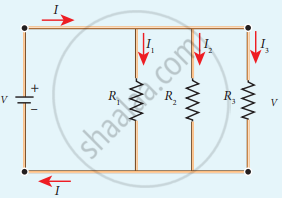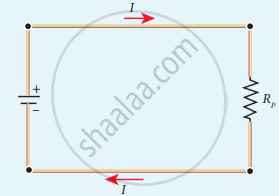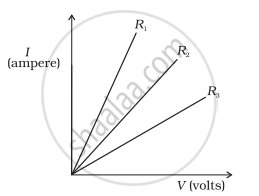Advertisements
Advertisements
प्रश्न
Explain the equivalent resistance of a parallel resistor network.
उत्तर
Resistors are in parallel when they are connected across the same potential difference as shown in the following figure.

Three resistors in parallel
In this case, the total current I that leaves the battery in split into three separate paths. Let I1, I2 and I3 be the current through the resistors R1, R2 and R3 respectively. Due to the conservation of charge, total current in the circuit I is equal to sum of the currents through each of the three resistors.
I = I1 + I2 + I3 ……. (1)
Since the voltage across each resistor is the same, applying Ohm’s law to each resistor, we have
`"I"_1 = "V"/"R"_1, "I"_2 = "V"/"R"_2, "I"_1 = "V"/"R"_3`
Substituting these values in equation (1), we get
I = `"V"/"R"_1 + "V"/"R"_2 + "V"/"R"_3`
= V`[1/"R"_1 + 1/"R"_2 + 1/"R"_3]`
I = `"V"/"R"_"p"`
`1/"R"_"p" = 1/"R"_1 + 1/"R"_2 + 1/"R"_3`
Here RP is the equivalent resistance of the parallel combination of the resistors. Thus, when a number of resistors are connected in parallel, the sum of the reciprocal of the values of resistance of the individual resistor is equal to the reciprocal of the effective resistance of the combination as shown in the following figure.

Equivalent resistance (RP) has the same current
APPEARS IN
संबंधित प्रश्न
Keeping the p.d. constant, the resistance of a circuit is halved. The current will become:
(a) one-fourth
(b) four time
(c) half
(d) double
A resistance of 40 ohms and one of 60 ohms are arranged in series across 220 volt supply. Find the heat in joules produced by this combination of resistances in half a minute.
What is an ohmic resistor? Give one example of an ohmic resistor. Draw a graph to show its current voltage relationship. How is the resistance of the resistor determined from this graph?
A wire of resistance 3 ohm and length 10 cm is stretched to length 30 cm. Assuming that it has a uniform cross section, what will be its new resistance?
Calculate the electric field in a copper wire of cross-sectional area 2.0 mm2 carrying a current of 1 A.
The resistivity of copper = 1.7 × 10–8 Ω m
What is meant by the drift speed of free electrons?
Define ampere and volt with respect to Ohm’s law.
A student carries out an experiment and plots the V-I graph of three samples of nichrome wire with resistances R1, R2 and R3 respectively. Which of the following is hue?

A student carries out an experiment and plots the V-I graph of three samples of nichrome wire with resistances R1, R2 and R3 respectively. Which of the following is true?

A metal rod of length 10 cm and a rectangular cross-section of 1 cm × `1/2` cm is connected to a battery across opposite faces. The resistance will be ______.
